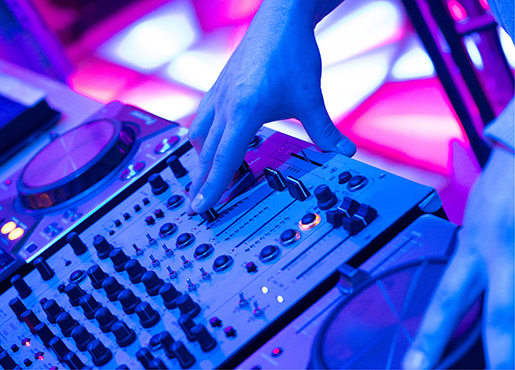
The Love of Electronic Dance Music
By Richard Paton
Every fall, millions of Americans listen to Electronic Dance Music.
They may not label it as such. Some, when asked, might well say they don’t really like that kind of music.
But listen, they do, as “Sandstorm” by Darude blasts through the PA systems at NFL and college football stadiums around the country.
Most evenings, they listen again, with dance music the sountrack to numerous advertisements on network and cable television.

Elements of EDM (which is as good a catch-all term as any for the myriad forms of dance music) have been embraced by pop artists.
That’s how far dance music, in one or another of its many sub-genres, has entered the mainstream.
It wasn’t always so.
When Electronic Currents first aired 25 years ago – yes, it has been that long – EDM was rarely heard here outside of a few clubs in large cities.
WGTE took a chance and, as the saying goes, blazed a new trail in airing Electronic Currents – leading where many other online and satellite stations now follow.
While some might say that blowing my own trumpet is the extent of my musical acumen, I take no credit for this. That credit belongs with Shirley Timonere, station President and CEO at the time, who allotted a half hour, one Sunday night a month to the show.
I was captivated by dance music back then, and remain so today, although my clubbing days, travelling to Chicago and Detroit to hear one of the great DJs, Paul Oakenfold, and displaying my agonizingly awkward dance moves in clubs on West 6th in Cleveland, are passed.
But as I indulge in my regular deep dives into EDM music sites in search of tracks to play on the show, the unadulterated joy of finding new music endures.
I can’t honestly say when I first encountered EDM, although if memory serves it would have been on one of my reglular visits to Engand to see family in the mid-90s.
Dance music had already taken hold there, and was already mainstream, played on the BBC’s pop music station, Radio 1, and on other local radio stations. EDM was hard to miss.
Iconic clubs like Gatecrasher, Cream, and The Ministry of Sound not only drew thousands of clubbers each weekend, but released legendary CD compilations. Music megastores like Virgin and HMV devoted entire departments to dance music.
And in part through listening to Radio 1, and part through happy hours spent digging though the racks at those London record stores, I found more artists and DJs that I wanted to hear, more styles of dance music to explore – and to include later on the show.
An immediate affinity for house music, and trance led to an appreciation for drum & bass and UK Garage, fueled by the ubiquity of those compilations across all genres.
My own experience suggests that EDM did not find this country to be as welcoming a host. Which is deeply ironic because – perhaps fodder for a later blog post – house music originated in Chicago, garage in New York, and techno just up I-75 in Detroit.
But like other forms of music – blues comes immediately to mind – American music is sometimes more fully accepted overseas. At least at first.
At a music conference several years ago organized by Billboard magazine, I was honored to be on a panel discussing dance music. And to this day I remember a fellow panelist opining in a tone that suggested she’d brook no objection, that dance music belonged in the underground.
But any effort to keep dance music confined to small clubs in big cities, for hip cognoscenti only, was futile. Although mainstream acceptance was some time coming.
Which brings us back to “Sandstorm.”
As Electronic Currents returns to Sunday night, where it began, I feel as though a circle of sorts has been completed. Though it is a circle that has not been unbroken, as the show was off the air for a couple of years.
From a half hour one Sunday night a month, to two hours every Sunday night, the evolution of the show, in an admittdly small way, has mirrored the growth and development of dance music in this country.
And I remain as excited to bring it to WGTE listeners today as I was 25 years ago.
- Home
- Schedules
- TV
- TV
- Local TV Programs
- Business | Life 360 with Kristi K.
- Toledo Stories
- To The Point with Doni Miller
- Listening with Keith Burris
- Ideas & Insights
- WGTE Presents
- BL360: Northwest Ohio Innovation Consortium
- Magic of the Old West End
- Freedom Means Never Surrender
- I&I: The Random Factor
- FF: National Cherry Festival
- TTP: Moms Demand Action For Gun Sense in America
- Watch Live
- Radio
- Education
- Community
- Support
- About
- Donate
- Watch Live



